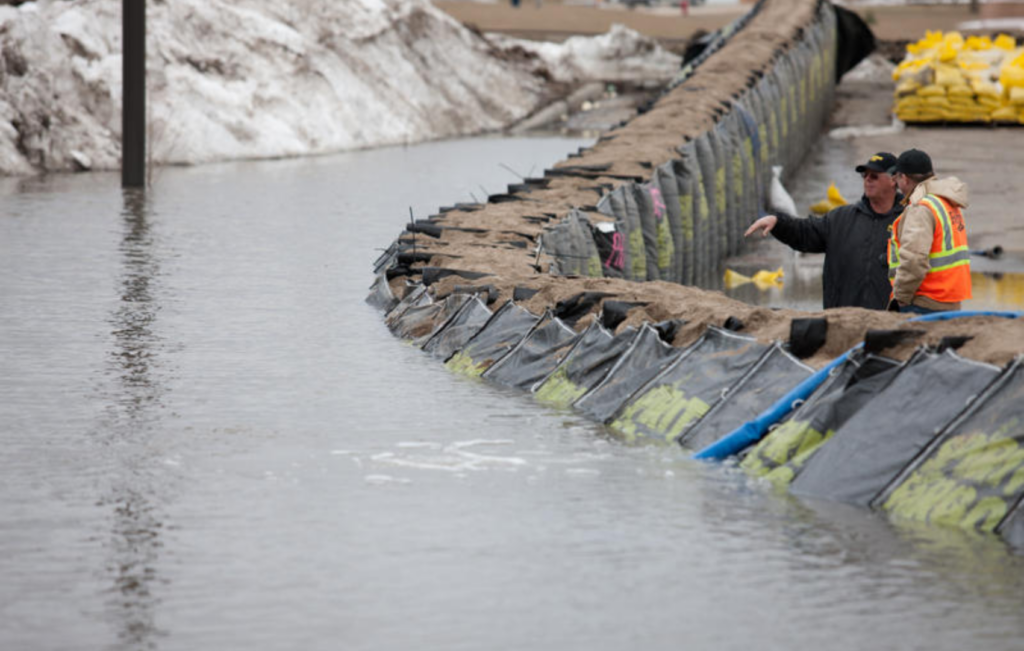What Is a Flood Wall?
Flood walls are necessary to prevent the dangerous, damaging effects of floods. Keep your community safe and protected from floods with TrapBag flood walls.

Flood walls are structures designed to block and divert flood waters from at-risk communities, public infrastructure, commercial properties, and residential buildings during a flooding event. Reliable flood protection is key to keeping the dangerous, damaging, expensive repercussions of floods from wreaking havoc on communities and their ecosystems, coastal and inland alike.
Municipalities are highly encouraged to invest in proper flood control methods like TrapBag® flood walls, which are a much more affordable solution when compared to the unpredictably high costs of flood damage and subsequent flood restoration.
Types of Flood Walls
There are a variety of flood walls available on the market, though their effectiveness and price point vary significantly.
Sandbag Flood Walls
Sandbag flood walls are bags filled with sand. While these may seem like a popular choice, this type of flood bag isn’t recommended. These singular bags must be stacked to an appropriate height and done so in a tight enough formation to prevent gaps which water would be able to leak through. For these reasons, sandbags can be tedious, time consuming, and difficult to place and stack before a flood, especially an emergency flooding event, when quick deployment time is of the essence.
Concrete Flood Barriers
Typically, concrete flood barriers are walls constructed around coastal cities, acting as a sort of seawall or water diversion wall, preventing large waves and flood water from reaching the nearby land. These permanent flood barriers are both expensive and difficult to erect, requiring multiple forms of heavy machinery to do so.
While concrete itself is water resistant, when the ground underneath is repeatedly saturated with water, it becomes loose and can cause the concrete to shift and break, rendering the barrier ineffective.
Sheet Metal Flood Barriers
Sheet pile seawalls are another type of permanent flood barrier. While sturdy and consistent in repelling water, these barriers must be driven into the ground with heavy machinery, weakening the surrounding ground and exacerbating erosion. This can become more diminished with each flood, making this form of flood barrier significantly less environmentally friendly than TrapBag barriers.
Self-Activating Flood Walls
Self-activating flood walls are small bags that divert flood water by absorbing it. This method of flood protection, however, is extremely ineffective for a few reasons. As the bags can only hold a small amount of water, once they reach their maximum absorption, water will pass over them. Similarly, these bags do not begin working until activated by water. If not pre-activated, there will be a period of time that water is running over them, defeating the purpose of having a flood barrier setup.
The Superior Flood Wall: TrapBag
When you’re faced with a serious flooding event and need reliable temporary or permanent protection, TrapBag barriers are the superior tool for flood wall construction.
Benefits of TrapBag Flood Walls
TrapBag barriers were engineered to be the best method of flood protection on the market, as they are:
-
- Versatile: TrapBags are made to be filled with sand or washed gravel when used temporarily, but can also be filled with concrete to form a permanent flood wall. They are easy to stack to create taller, wider structures when necessary.
- Durable and dependable: Created from a high-strength geotextile material, TrapBags are made to last at least five years after deployment. The accordion-style structure of the bags ensures leaks are non-existent, even if a singular cell is compromised.
- Efficient: The accordion-style structure of TrapBags makes deploying them a quick task—no grabbing, transporting, and stacking individual bags one by one. Save time when it’s most important with TrapBag.
- Affordable: TrapBag barriers are a more cost-effective flood wall solution—they require 40% less fill than traditional sandbags.
Permanent vs. Temporary Flood Walls
Permanent flood walls are erected with the intention of lasting for many, many years—you can certainly find this form of flood protection around coastal communities or those near lakes or rivers prone to flooding. These walls are meant to combat floods consistently and effectively, subsequently saving municipalities and commercial property owners thousands on flood damage restoration. For an affordable but extremely reliable form of a permanent flood wall, choose TrapBags.
Temporary flood walls can be used to support existing flood protection infrastructure, but also may be used by a community anywhere in the world. Extreme rainstorms can cause floods that wreak serious havoc on inland municipalities, and temporary flood protection is necessary to protect lives, buildings, homes, and farm land. TrapBag barriers are great for quickly deployable but extremely effective flood walls.
How to Build a Flood Wall with TrapBag
Overall, TrapBag flood walls are simple to construct. To begin the installation, pull the bundle apart like an accordion and set it in the desired location, with the vertical side of the pentagon-shaped bag towards incoming flood water. TrapBag barriers come in 50-ft sections and are easily connected for additional protection, making them simpler and quicker to install in comparison to other types of flood barriers.
Once the bags are placed at their destination, they are able to be filled. Add filling into the two end cells three-fourths of the way with 100 pounds per cubic foot of material minimum. Once filled, the installation crew can pull the chain of cells tightly while simultaneously filling the next two cells that are against the last cell three-fourths of the way full. Keep in mind, the last cell must be completely empty in order to make a connection to the second chain of cells, or you can make the connection prior to filling the two cells that are next to the last cell halfway.
While heavy machinery can be utilized in the installation process, it is not necessary. A group of a few installers can easily place the bags together, covering a large area within an hour to a few hours.
Flood Walls to Protect Your Community or Business
Investing in flood protection is becoming more universally necessary with climate change continuing to impact weather patterns that lead to dangerous flooding events. While flood protection is undoubtedly required for mitigating damage to public infrastructure, commercial properties, and residential homes, there are many industries that can also benefit from investing in effective flood walls, including:
- Construction: Flooding can cause expensive, time-consuming setbacks on a construction site. The implementation of a TrapBag flood wall ensures the on-going project won’t be damaged, saving the crew time and saving investors money.
- Mining: Mine flooding can be incredibly dangerous to mine workers. It can also cause significant erosion that weakens the integrity of the mining site. Floods can leach chemicals from mining substrate and contaminate nearby water sources, leading to serious issues for the surrounding environment. Flood walls work to divert these waters, mitigating many potentially dangerous and expensive issues.
- Agriculture: Flooding can ruin farmland and crops, devastating months of hard work that farmers spend laboring. Flood walls are necessary to divert water from low-lying areas that can be wiped out during a flood.
- Municipal engineers: Engineers are responsible for creating structures that protect communities and public infrastructure from flooding disasters. TrapBags are an affordable solution engineers can employ permanently or temporarily as flood protection.
Get Reliable Commercial Flood Protection
Protect your community against devastating flood waters with effective flood walls from TrapBag. Send us a message today to inquire about getting TrapBags delivered to your area—TrapBags can be shipped anywhere globally.
Meet the author
Get the Dirt Before the Flood Hits
Stay ahead of flooding, erosion, and disaster response challenges. The Dirt, TrapBag’s monthly newsletter, delivers field-tested tips, real-world case studies, and the latest in barrier technology straight to your inbox.

